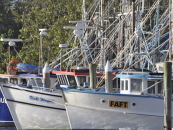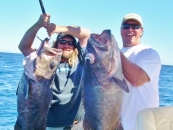There’s always something in the air when it comes to fishing the backwaters of tributaries, streams and inlets. The thought of walking the tree-lined banks knowing that fish inhabit the waters lapping the edge of your feet. But what sort of fish are we talking about? Various fish species need water flow from mountains, drains, hill sides, and in general just rain to help them move from one stretch to another for in dry weather times, fish can become stuck in land-locked waterholes ready for your picking.
Surprisingly, species can consist of both fresh and saltwater species that can adapt to brackish waters often found in these situations. Bream, mangrove jacks and bass are the three main fish that I regularly catch. The Gold Coast is big on boating. The highest amount of registered boats per capita in the southern hemisphere, the fastest growing region in Australia and combine these together and it equals pressure and loads of it.
To me the waterways here are still like the wild west, very little control when it comes to policing the activity in a narrowing waterway but all of this fades away when you slip upstream to where boats can’t go and people don’t venture.
Use of drones these days is so beneficial when fishing these backwaters. Often the grass and banks are so thick you can’t even see the waterholes from the ground but taking a birds eye view changes everything. Yes you still have to trudge through the tree and grass lined banks to get there but you have a vision, a line of sight, a mark where to get to. A recent film shoot we did encompassed all of the above and the result was phenomenal, one of the prettiest, quickest film shoots for Step Outside and shot literally twenty five minutes from the heart of the city. I was told of this spot from a mate of mine, not a big fisherman more of a hunter (not that he hunts in these areas but just likes to escape and walk through the bush, kind of weird but I get him). He mentioned these small holes that had fish darting around, they would sun themselves in the shallows before scooting off into the timber and deeper water on the other side of the creek which was only 8 feet away. Sounded narrow but we were up for the challenge. The gear we armed ourselves with consisted of a light 1-3kg Shimano Jewel spin rod matched with a Shimano graphite Exsence 3000 spin reel. Line class, 5kg Kairiki Braid and a rod length of 3kg fluorocarbon leader. My lures of choice had to suit the surrounds.
Knowing there had been zero rain recently I knew surface frog lures wouldn’t work the best, deep diving lures weren’t going to cut it either for it sounded very snaggy where we were about to head to. Soft plastics, I thought; nope, they sink, and although a weedless plastic probably would’ve worked, I needed something that stayed on the surface then dived down shallow enough not to get snagged but enough to pull past the logs and rocky banks. The RMG Scorpion was the lure of choice, colour Christmas Beetle. This lure could be cast an easy 20 metres, it would float on the surface before being cranked back – perfect.
My mate, we’ll call him Luke, already had a track into the desired area where he wanted to take me so the next morning, nice and early, we were off. Thankfully, he knew the track for me. I couldn’t see anything from the heavy cover in front of me.
Launching the drone on the crack of dawn, finding the right hole with minimal overhang, was the easy part. Now it was just a matter getting through the scrub to wet a line. The creek bed sank 3 metres down from the top of the land, waterholes were situated every 30 metres or so. It was just a matter of sliding down into the creek bed and walking up or downstream for a fish.
One of the first things we heard was the deafening sound of the cicadas in the surrounding bush and I knew my choice of lure was spot on. The first cast was laid up beside a log, the lure hit the water, I let it sit for a few seconds before not retrieving but just slightly twitching the rod tip so the lure would slowly move on the surface to imitate a bug that had fallen from the tree and was now in distress on the waters surface. Then bang a solid fish smacked the lure and it was on for about three seconds before ripping back into the log and gone. Fortunately, the lure got caught on one of the branches on his way back in pulling the lure out of the fishss mouth and leaving me to sneak on in and retrieve the lure, perfect – but unfortunately walking in and moving around the log also spoiled that hole, the fish were spooked so we walked up to the next and laid the second cast with a similar action and, yep, within a few seconds, a similar hook-up this time, we were ready and the fight began. So many snags right to your feet and this fish wanted to be in every one of them. It was an Australian bass, a native fish found along the eastern seaboard from the sub tropics of Queensland right down into Victoria. A tough fighter making them a brilliant sportfish on the right tackle.
One thing I learnt whilst fishing previous holes like this is not to let the fish go where you are fishing. They’ll instantly shut down. So after a quick walk back to the previous spot, the fish released. We ended up pulling another five from there before moving upstream, and like the previous holes the fish were on, thick and hungry, eating the lure within the first few seconds of landing on the water. The country was getting thicker and heavier making it harder to cast so we ventured back downstream using the drone to find a shortcut back to the lower reaches before carving a track through the scrub.
The water seemed brackish at the next spot, some waterlilies and some mangroves and, yep, loads of covers, trees laying across the creek bed, debris from last year’s floods, but now it was 100% the opposite. These land-locked honey holes had become a fish’s prison but an angler’s dream. The next cast around what looked like a dam wall made of tree trunks and debris pulled a mangrove jack. Nothing big but it was still a jack in his 30’s weighing around 700 grams, good fun on light tackle.
If you have the urge to capture moments like this for yourself, be aware that snakes inhabit the banks around these areas. We saw a few and fortunately for my hunting mate he made me aware of them before I even knew they were there. This goes to show that even in a heavily populated area, fish holes like this still exist and fishing in general is still first class.
Watch Paul every weekend on 7Mate as they
Step Outside. www. stepoutside.com.au
Published in print April-June 2023
































